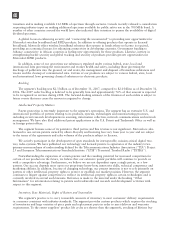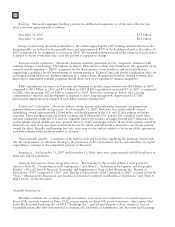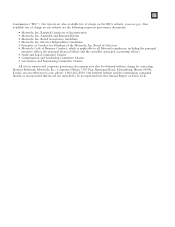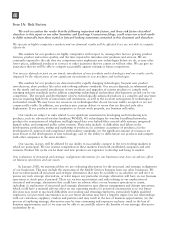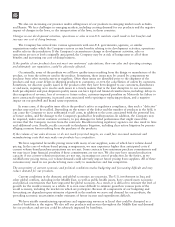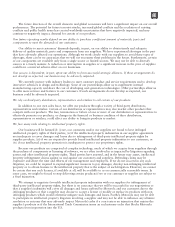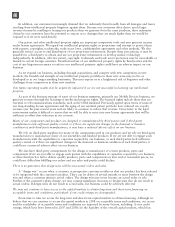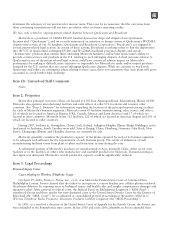Motorola 2007 Annual Report Download - page 31
Download and view the complete annual report
Please find page 31 of the 2007 Motorola annual report below. You can navigate through the pages in the report by either clicking on the pages listed below, or by using the keyword search tool below to find specific information within the annual report.
been negatively impacted by the U.S. sub-prime mortgage situation; and (iii) the current state of the economy,
including the telecommunications industry. There can be no assurances that we will continue to have access to the
capital markets on terms acceptable to us.
Our debt ratings are considered “investment grade.” If our credit ratings were to decline two levels from the
current Fitch and S&P ratings, the Company’s long-term debt would no longer be considered investment grade and
our financial flexibility would be reduced and our cost of borrowing would increase. Some of the factors that
impact our credit ratings, including the overall economic health of the telecommunications industry and the U.S.
economy, are outside of our control. There can be no assurances that our current credit ratings will continue.
Our commercial paper is rated “A-2/P-2/F-2.” Our A-2 and F-2 ratings include a “watch negative.” Although
we currently have access to the commercial paper markets, there can be no assurances that we will continue to
have access to the commercial paper markets on terms acceptable to us.
We may not be able to borrow funds under our credit facility if we are not able to meet the conditions to
borrowing in our facility.
We view our existing five-year revolving domestic credit facility as a source of available liquidity. This facility
contains various conditions, covenants and representations with which we must be in compliance in order to
borrow funds. We have never borrowed under this facility or previous domestic revolving credit facilities.
However, if we wish to borrow under this facility in the future, there can be no assurance that we will be in
compliance with these conditions, covenants and representations.
We may continue to make strategic acquisitions of other companies or businesses and these acquisitions introduce
significant risks and uncertainties, including risks related to integrating the acquired businesses and achieving
benefits from the acquisitions.
In order to position ourselves to take advantage of growth opportunities, we have made, and may continue to
make, strategic acquisitions that involve significant risks and uncertainties. These risks and uncertainties include:
(i) the difficulty in integrating newly-acquired businesses and operations in an efficient and effective manner; (ii) the
challenges in achieving strategic objectives, cost savings and other benefits from acquisitions; (iii) the risk that our
markets do not evolve as anticipated and that the technologies acquired do not prove to be those needed to be
successful in those markets; (iv) the potential loss of key employees of the acquired businesses; (v) the risk of
diverting the attention of senior management from our operations; (vi) the risks of entering new markets in which
we have limited experience; (vii) risks associated with integrating financial reporting and internal control systems;
(viii) difficulties in expanding information technology systems and other business processes to accommodate the
acquired businesses; and (ix) future impairments of goodwill of an acquired business.
Acquisition candidates in the industries in which we participate may carry higher relative valuations (based on
their earnings) than we do. This is particularly evident in software and services businesses. Acquiring a business
that has a higher valuation than Motorola may be dilutive to our earnings, especially when the acquired business
has little or no revenue. In addition, we may not pursue opportunities that are highly dilutive to near-term earnings
and have, in the past, foregone certain of these acquisitions.
Key employees of acquired businesses may receive substantial value in connection with a transaction in the
form of change-in-control agreements, acceleration of stock options and the lifting of restrictions on other equity-
based compensation rights. To retain such employees and integrate the acquired business, we may offer additional
retention incentives, but it may still be difficult to retain certain key employees.
Our future operating results may be negatively impacted if we do not execute a successful silicon and software
strategy for our Mobile Devices business.
As part of our ongoing effort to improve the product portfolio of our Mobile Devices business, we are in the
process of transitioning our silicon and software platforms to lower our cost to produce devices and to enable
richer consumer experiences. Failure to execute this transition in a timely and effective manner may cause us to be
competitively disadvantaged in many areas, including but not limited to, cost, time to market and the ability to
ramp-up production in a timely fashion with acceptable quality and improved/additional features.
23



